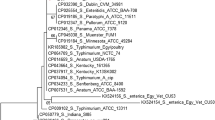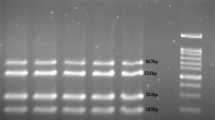Abstract
Members of Salmonella enterica are important foodborne pathogens of significant public health concern worldwide. This study aimed to determine a range of virulence genes among typhoidal (S. typhi) and non-typhoidal (S. enteritidis) strains isolated from different geographical regions and different years. A total of 87 S. typhi and 94 S. enteritidis strains were tested for presence of 22 virulence genes by employing multiplex PCR and the genetic relatedness of these strains was further characterized by REP-PCR. In S. typhi, invA, prgH, sifA, spiC, sopB, iroN, sitC, misL, pipD, cdtB, and orfL were present in all the strains, while sopE, agfC, agfA, sefC, mgtC, and sefD were present in 98.8, 97.7, 90.8, 87.4, 87.4 and 17.2 %, of the strains, respectively. No lpfA, lpfC, pefA, spvB, or spvC was detected. Meanwhile, in S. enteritidis, 15 genes, agfA, agfC, invA, lpfA, lpfC, sefD, prgH, spiC, sopB, sopE, iroN, sitC, misL, pipD, and orfL were found in all S. enteritidis strains 100 %, followed by sifA and spvC 98.9 %, pefA, spvB and mgtC 97.8 %, and sefC 90.4 %. cdtB was absent from all S. enteritidis strains tested. REP-PCR subtyped S. typhi strains into 18 REP-types and concurred with the virulotyping results in grouping the strains, while in S. enteritidis, REP-PCR subtyped the strains into eight profiles and they were poorly distinguishable between human and animal origins. The study showed that S. typhi and S. enteritidis contain a range of virulence factors associated with pathogenesis. Virulotyping is a rapid screening method to identify and profile virulence genes in Salmonella strains, and improve an understanding of potential risk for human and animal infections.




Similar content being viewed by others
References
Galanis E, Lo Fo Wong DM, Patrick ME, Binsztein N, Cieslik A, Chalermchikit T, Aidara-Kane A, Ellis A, Angulo FJ, Wegener HC, World Health Organization Global Salm-Surv (2006) Web-based surveillance and global Salmonella distribution, 2000–2002. Emerg Infect Dis 12:381–388
Hensel M (2004) Evolution of pathogenicity islands of Salmonella enterica. Int J Med Microbiol 294:95–102
Skyberg J, Logue C, Nolan L (2006) Virulence genotyping of Salmonella spp. with multiplex PCR. Avian Dis 50:77–81
Galán JE, Wolf-Watz H (2006) Protein delivery into eukaryotic cells by type III secretion machines. Nature 444:567–573
Rychlik I, Gregorova D, Hradecka H (2006) Distribution and function of plasmids in Salmonella enterica. Vet Microbiol 112:1–10
de Jong HK, Parry CM, van der Poll T, Wiersinga WJ (2012) Host–pathogen interaction in invasive salmonellosis. PLoS Pathog 8:e1002933
Vernikos GS, Parkhill J (2006) Interpolated variable order motifs for identification of horizontally acquired DNA: revisiting the Salmonella pathogenicity islands. Bioinformatics 22:2196–2203
Garai P, Gnanadhas DP, Chakravortty D (2012) Salmonella enterica serovars Typhimurium and Typhi as model organisms: revealing paradigm of host-pathogen interactions. Virulence 3:377–388
Crump JA, Mintz ED (2010) Global trends in typhoid and paratyphoid fever. Clin Infect Dis 50:241–246
Chai LC, Kong BH, Elemfareji OI, Thong KL (2012) Variable carbon catabolism among Salmonella enterica serovar Typhi isolates. PLoS ONE 7:e36201
Demczuk W, Woodward D, Ahmed R, Clark C, Tabor H, Dore K, Ciampa N, Muckle A (2005) Laboratory surveillance data for enteric pathogens in Canada: annual summary 2002 and 2003. Winnipeg, MB, Health Canada. http://publications.gc.ca/pub?id=279282&sl=0. Accessed 1 April 2013
Heithoff DM, Shimp WR, Lau PW, Badie G, Enioutina EY, Daynes RA, Byrne BA, House JK, Mahan MJ (2008) Human Salmonella clinical isolates distinct from those of animal origin. Appl Environ Microbiol 74:1757–1766
Nazemi A, Mirinargasi M, Merikhi N, Sharifi SH (2011) Distribution of pathogenic genes aatA, aap, aggR, among Uropathogenic Escherichia coli (UPEC) and their linkage with StbA gene. Indian J Microbiol 51:355–358
Lim KT, Hanifah YA, Yusof MYM, Thong KL (2012) Characterisation of the virulence factors and genetic types of methicillin susceptible Staphylococcus aureus from patients and healthy individuals. Indian J Microbiol. doi:10.1007/s12088-012-0286-7
Parvathi A, Mendez D, Anto C (2011) Distribution of putative virulence genes and antimicrobial drug resistance in Vibrio harveyi. Indian J Microbiol 51:332–337
Versalovic J, Koeuth T, Lupski JR (1991) Distribution of repetitive DNA sequences in eubacteria and application to fingerprinting of bacterial genomes. Nucleic Acids Res 19:6823–6831
Huehn S, La Ragione RM, Anjum M, Saunders M, Woodward MJ, Bunge C, Helmuth R, Hauser E, Guerra B, Beutlich J, Brisabois A, Peters T, Svensson L, Madajczak G, Litrup E, Imre A, Herrera-Leon S, Mevius D, Newell DG, Malorny B (2010) Virulotyping and antimicrobial resistance typing of Salmonella enterica serovars relevant to human health in Europe. Foodborne Pathog Dis 7:523–535
Khoo CH, Cheah YK, Lee LH, Sim JH, Salleh NA, Sidik SM, Radu S, Sukardi S (2009) Virulotyping of Salmonella enterica subsp. enterica isolated from indigenous vegetables and poultry meat in Malaysia using multiplex-PCR. Antonie Van Leeuwenhoek 96:441–457
Thong KL, Cheong YM, Puthucheary SD, Koh CL, Pang T (1994) Epidemiologic analysis of sporadic Salmonella typhi isolates and those from outbreaks by pulsed-field gel electrophoresis. J Clin Microbiol 32:1135–1141
Thong KL, Puthucheary SD, Yassin RM, Sudarmono P, Padmidewi M, Soewandojo E, Handojo I, Sarasombath S, Pang T (1995) Analysis of Salmonella typhi isolates from Southeast Asia by pulsed-field gel electrophoresis. J Clin Microbiol 33:1938–1941
Thong KL, Cordano AM, Yasin RM, Pang T (1996) Molecular analysis of environmental and human isolates of Salmonella typhi. Appl Environ Microbiol 62:271–274
Thong KL, Lai WL, Dhanoa A (2011) Antimicrobial susceptibility and pulsed: field gel electrophoretic analysis of Salmonella in a tertiary hospital in northern Malaysia. J Infect Public Health 4:65–72
Tiong V, Thong KL, Yusof MYM, Abu Hanifah Y, Sam JI-C, Hassan H (2010) Macrorestriction analysis and antimicrobial susceptibility profiling of Salmonella enterica at a University Teaching Hospital, Kuala Lumpur. Jpn J Infect Dis 63:317–322
Hughes L, Shopland S, Wigley P, Bradon H, Leatherbarrow A, Williams N, Bennett M, de Pinna E, Lawson B, Cunningham A, Chantrey J (2008) Characterization of Salmonella enterica serotype Typhimurium isolates from wild birds in northern England from 2005–2006. BMC Vet Res 4:4
Bäumler AJ, Gilde AJ, Tsolis RM, van der Velden AWM, Ahmer BM, Heffron F (1997) Contribution of horizontal gene transfer and deletion events to the development of distinctive patterns of fimbrial operons during evolution of Salmonella serotypes. J Bacteriol 179:317–322
Bäumler AJ, Heffron F (1995) Identification and sequence analyses of lpfABCDE, a fimbrial putative operon of Salmonella typhimurium. J Bacteriol 177:2087–2097
Gibson DL, White AP, Rajotte CM, Kay WW (2007) AgfC and AgfE facilitate extracellular thin aggregative fimbriae synthesis in Salmonella enteritidis. Microbiology 153:1131–1140
Rahn K, De Grandis SA, Clarke RC, Mcewen SA, Galán JE, Ginocchio C, Curtiss R III, Gyles CL (1992) Amplification of an invA gene sequence of Salmonella typhimurium by polymerase chain reaction as a specific method of detection of Salmonella. Mol Cell Probes 6:271–279
Soto SM, Rodríguez I, Rodicio MR, Vila J, Mendoza MC (2006) Detection of virulence determinants in clinical strains of Salmonella enterica serovar Enteritidis and mapping on macro restriction profiles. J Med Microbiol 55:365–373
Chiu C, Ou J (1996) Rapid identification of Salmonella serovars in feces by specific detection of virulence genes, invA and spvC, by an enrichment broth culture-multiplex PCR combination assay. J Clin Microbiol 34:2619–2622
Bennasar A, de Luna G, Cabrer B, Lalucat J (2000) Rapid identification of Salmonella typhimurium, S. enteritidis and S. virchow isolates by polymerase chain reaction based fingerprinting methods. Int Microbiol 3:31–38
Ibarra JA, Steele-Mortimer O (2009) Salmonella: the ultimate insider. Salmonella virulence factors that modulate intracellular survival. Cell Microbiol 11:1579–1586
Reis RS, Horn F (2010) Enteropathogenic Escherichia coli, Samonella, Shigella and Yersinia: cellular aspects of host-bacteria interactions in enteric diseases. Gut Pathog 2:8
Alix E, Blanc-Potard A-B (2008) Peptide-assisted degradation of the Salmonella MgtC virulence factor. EMBO J 27:546–557
Kaneshige T, Yaguchi K, Ohgitani T (2009) Siderophore receptor IroN is an important protective antigen against Salmonella infection in chickens. Avian Dis 53:563–567
Haghjoo E, Galán JE (2004) Salmonella typhi encodes a functional cytolethal distending toxin that is delivered into host cells by a bacterial-internalization pathway. Proc Natl Acad Sci USA 101:4614–4619
Ceelen LM, Decostere A, Ducatelle R, Haesebrouck F (2006) Cytolethal distending toxin generates cell death by inducing a bottleneck in the cell cycle. Microbiol Res 161:109–120
Thomson NR, Clayton DJ, Windhorst D, Vernikos G, Davidson S, Churcher C, Quail MA, Stevens M, Jones MA, Watson M, Barron A, Layton A, Pickard D, Kingsley RA, Bignell A, Clark L, Harris B, Ormond D, Abdellah Z, Brooks K, Cherevach I, Chillingworth T, Woodward J, Norberczak H, Lord A, Arrowsmith C, Jagels K, Moule S, Mungall K, Saunders M, Whitehead S, Chabalgoity JA, Maskell D, Humphreys T, Roberts M, Barrow PA, Dougan G, Parkhill J (2008) Comparative genome analysis of Salmonella enteritidis PT4 and Salmonella Gallinarum 287/91 provides insights into evolutionary and host adaptation pathways. Genome Res 18:1624–1637
Clayton DJ, Bowen AJ, Hulme SD, Buckley AM, Deacon VL, Thomson NR, Barrow PA, Morgan E, Jones MA, Watson M, Stevens MP (2008) Analysis of the role of 13 major fimbrial subunits in colonisation of the chicken intestines by Salmonella enterica serovar Enteritidis reveals a role for a novel locus. BMC Microbiol 8:228
Velge P, Wiedemann A, Rosselin M, Abed N, Boumart Z, Chaussé AM, Grépinet O, Namdari F, Roche SM, Rossignol A, Virlogeux-Payant I (2012) Multiplicity of Salmonella entry mechanisms, a new paradigm for Salmonella pathogenesis. Microbiologyopen 1:243–258
Popat R, Crusz SA, Diggle SP (2008) The social behaviours of bacterial pathogens. Br Med Bull 87:63–75
Kalia VC (2013) Quorum sensing inhibitors: an overview. Biotechnol Adv 31:224–245
Oliveira SDd, Bessa MC, Santos LRd, Cardoso MRd, Brandelli A, Canal CW (2007) Phenotypic and genotypic characterization of Salmonella enteritidis isolates. Braz J Microbiol 38:720–728
Acknowledgments
The study was supported by Grants PS 284/2008C and UM.C/HIR/MOHE/02 (A000002-50001) from the University of Malaya.
Author information
Authors and Affiliations
Corresponding author
Rights and permissions
About this article
Cite this article
Elemfareji, O.I., Thong, K.L. Comparative Virulotyping of Salmonella typhi and Salmonella enteritidis . Indian J Microbiol 53, 410–417 (2013). https://doi.org/10.1007/s12088-013-0407-y
Received:
Accepted:
Published:
Issue Date:
DOI: https://doi.org/10.1007/s12088-013-0407-y




